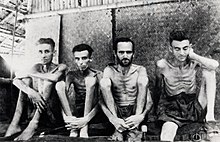User:Peacemaker67/Military History Book Reviews
The Lost Battalions - by Tom Gilling |

![]()
![]()
![]()
![]()
![]()
- By Peacemaker67
Tom Gilling is an Australian novelist, so far as I can tell this his first military history book. It tells the story of two Australian battalions of World War II, the 2/2nd Pioneer Battalion and 2/3rd Machine Gun Battalion. These two battalions fought in the Syria–Lebanon campaign in mid-1941, then briefly fought the Japanese on Java before their capture in February the following year. The majority of the book is dedicated to the members of both battalions that worked on the notorious Thailand-Burma railway. It is subtitled "A battle that could not be won, an island that could not be defended, an ally that could not be trusted". I read it at Hawkeye7's suggestion, as part of my work on Arthur Blackburn VC, who commanded the 2/3rd Machine Gun Battalion.
Gilling begins by briefly covering the raising of the two battalions, their service in Syria and Lebanon, and the fighting on Java. These first four chapters are essentially a summary of the relevant parts of Andrew Faulkner's 2008 book Arthur Blackburn, VC: An Australian Hero, His Men, and Their Two World Wars, and very little of this is new material. According to the acknowledgements, Faulkner helped Gilling with the book, so this is unsurprising if a little redundant. However, the book gets interesting at the point the Australians are captured, as the men of these two battalions were largely separated from their senior officers such as Blackburn, and the majority of both battalions were soon sent to help build the Thailand-Burma railway, with the two battalions working towards the middle from opposite ends. At this point, Gilling really brings in the accounts of two survivors, who he interviewed for the book. I was particularly interested in the account of the survivor from the 2/3rd Machine Gun Battalion, as he is still alive and I know him to talk to, but have never heard anything about his experiences on the railway. It is in the chapters about the railway that this book hits its straps. The descriptions of the camps along the railway, the treatment meted out to the POWs and the illnesses they suffered are all compelling and well-written. The book ends with both men being liberated in Japan after being shipped there through submarine-infested waters once the railway was completed. In total, 139 members of the 2/3rd Machine Gun Battalion died on the railway, along with 178 from the 2/2nd Pioneers.
Aside from the regurgitation of Faulkner in the early chapters, the book really fails to live up to the sub-title, as the poor decision-making that led the Australians to be landed on Java and the unwillingness of the Dutch to fight are only glossed over briefly. Faulkner and others have already examined these aspects in detail, and the book is poorly subtitled, perhaps intending to make it sound controversial. It is not. The book's real essence is in the railway experience as seen through the eyes of two men, although Gilling does draw in other first-hand accounts from survivors' memoirs, such as the surgeon Weary Dunlop's war diaries.
Publishing details: Gilling, Tom (2018). The Lost Battalions. Crows Nest, New South Wales: Allen & Unwin. ISBN 978-1-76063-708-8.
